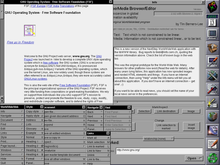
A web browser (commonly referred to as a browser) is a software application for accessing information on the World Wide Web. When a user requests a web page from a particular website, the web browser retrieves the necessary content from a web server and then displays the page on the user's device.
A web browser is not the same thing as a search engine, though the two are often confused.[1][2] For a user, a search engine is just a website that provides links to other websites. However, to connect to a website's server and display its web pages, a user must have a web browser installed.[3]
Web browsers are used on a range of devices, including desktops, laptops, tablets, and smartphones. In 2019, an estimated 4.3 billion people used a browser.[4] The most used browser is Google Chrome, with a 64% global market share on all devices, followed by Safari with 18%.[5] Other notable browsers include Firefox and Microsoft Edge.
The first web browser, called WorldWideWeb, was created in 1990 by Sir Tim Berners-Lee.[6] He then recruited Nicola Pellow to write the Line Mode Browser, which displayed web pages on dumb terminals; it was released in 1991.[7]
1993 was a landmark year with the release of Mosaic, credited as "the world's first popular browser".[8] Its innovative graphical interface made the World Wide Web system easy to use and thus more accessible to the average person. This, in turn, sparked the Internet boom of the 1990s, when the Web grew at a very rapid rate.[8] Marc Andreessen, the leader of the Mosaic team, soon started his own company, Netscape, which released the Mosaic-influenced Netscape Navigator in 1994. Navigator quickly became the most popular browser.[9]
Microsoft debuted Internet Explorer in 1995, leading to a browser war with Netscape. Microsoft was able to gain a dominant position for two reasons: it bundled Internet Explorer with its popular Microsoft Windows operating system and did so as freeware with no restrictions on usage. Eventually the market share of Internet Explorer peaked at over 95% in 2002.[10]
In 1998, Netscape launched what would become the Mozilla Foundation to create a new browser using the open source software model. This work evolved into Firefox, first released by Mozilla in 2004. Firefox reached a 28% market share in 2011.[12]
Apple released its Safari browser in 2003. It remains the dominant browser on Apple platforms, though it did not become popular elsewhere.[12]
Google debuted its Chrome browser in 2008, which steadily took market share from Internet Explorer and became the most popular browser in 2012.[13][14] Chrome has remained dominant ever since.
Microsoft released its Edge browser in 2015 as part of the Windows 10 release, and rebuilt it as a Chromium-based browser in 2019. (Internet Explorer is still used on older versions of Windows.)